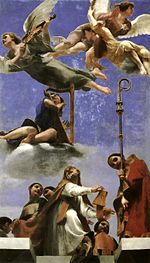2012 (286)
2013 (161)
2019 (2)

Guido Cagnacci
Guido Cagnacci (January 19, 1601 – 1663) was an Italian painter of the Baroque period, who produced many works characterized by their use of chiaroscuro and their sensual subjects. He was influenced by the masters of the Bolognese School.
Contents
[hide]
Biography[edit]
Cagnacci was born in Santarcangelo di Romagna, near Rimini. He worked in Rimini from 1627 to 1642. After that, he moved to work in Forlì, where he would have been able to observe the paintings of Melozzo.[1]
Prior to living in Forlì he had been in Rome, where he had come in contact with Guercino, Guido Reni and Simon Vouet. He may have had an apprenticeship with the elderly Ludovico Carracci in Bologna. His initial output includes many devotional subjects. But moving to Venice under the name of Guico Baldo Canlassi da Bologna, he renewed a friendship with Nicolas Regnier, and dedicated himself to private salon paintings, often depicting sensuous naked women from thigh upwards, including Lucretia, Cleopatra, and Mary Magdalene.[2] This allies him to a strand of courtly painting, epitomized in Florence by Francesco Furini, Simone Pignoni and others. In 1650, he moved to Venice. In 1658, he traveled to Vienna, where he remained under patronage of the Emperor Leopold I.[3]
His life was often tempestuous, as can be characterized by the 1628 episode of a failed elopement with an aristocratic widow. Some contemporaries describe him as eccentric, unreliable and of doubtful morality. He is said to have enjoyed the company of cross-dressing models.[2] He died in Vienna in 1663.
Cagnacci's work was, in one view, "entirely unappreciated by his contemporaries," but reassessed by modern critics; his painting is "warm with the heightened tones of grazing light, rich in the play of shadows and colors."[4]
Selected works[edit]
- Procession of the Holy Sacrament (Salucedio)
- Christ with Saints Joseph and Eligius (1635)
- Madonna with saints Andre Corsini Teresa and Maria Maddalena de' Pazzi (1640, Sant'Arcangelo)
- Frescoes in Cappella della Madonna del Fuoco (Duomo, Forlì)
- Allegory of spheral Astrology (Pinacoteca civica, Forlì)
- Glory of Saints Valerian and Mercurial (Faenza)
- Leopold I portrait (Vienna)
- Calling of Saint Matthew (Museo della Città - Rimini)
- Allegorical Naked Figure (private)
- The Death of Cleopatra (Pinacoteca di Brera, Milan)
- Death of Cleopatra (Kunsthistorisches Museum, Gemäldegalerie, Vienna)
- Death of Lucretia [1]
- Scolding of Mary Magdalene (Norton Simon Museum)
Gallery[edit]
- Selected works
-
Maria Magdalena with angels












